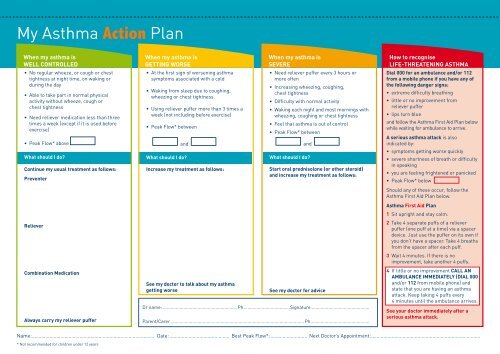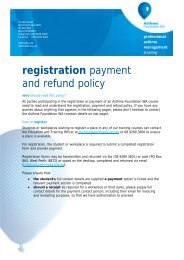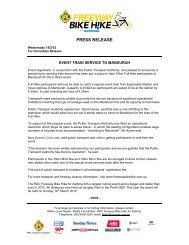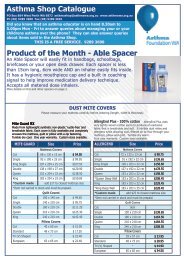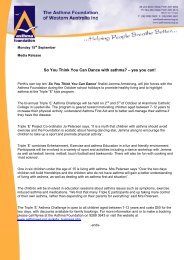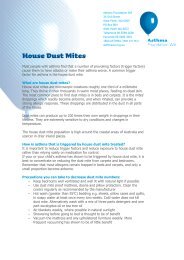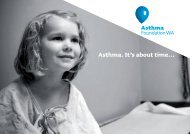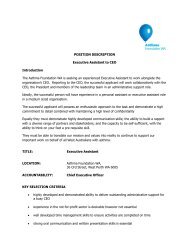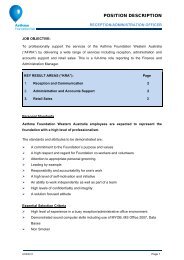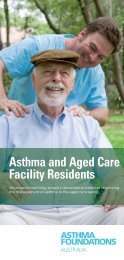My Asthma Action Plan
My Asthma Action Plan
My Asthma Action Plan
You also want an ePaper? Increase the reach of your titles
YUMPU automatically turns print PDFs into web optimized ePapers that Google loves.
<strong>My</strong> <strong>Asthma</strong> <strong>Action</strong> <strong>Plan</strong>When my asthma iswell controlled• No regular wheeze, or cough or chesttightness at night time, on waking orduring the day• Able to take part in normal physicalactivity without wheeze, cough orchest tightness• Need reliever medication less than threetimes a week (except if it is used beforeexercise)• Peak Flow* aboveWhat should I do?Continue my usual treatment as follows:PreventerRelieverCombination MedicationAlways carry my reliever pufferWhen my asthma isGETTING WORSE• At the first sign of worsening asthmasymptoms associated with a cold• Waking from sleep due to coughing,wheezing or chest tightness• Using reliever puffer more than 3 times aweek (not including before exercise)• Peak Flow* betweenandWhat should I do?Increase my treatment as follows:See my doctor to talk about my asthmagetting worseWhen my asthma issevere• Need reliever puffer every 3 hours ormore often• Increasing wheezing, coughing,chest tightness• Difficulty with normal activity• Waking each night and most mornings withwheezing, coughing or chest tightness• Feel that asthma is out of control• Peak Flow* betweenandWhat should I do?Start oral prednisolone (or other steroid)and increase my treatment as follows:See my doctor for adviceDr name:...........................................................Ph....................................Signature..............................................Parent/Carer......................................................................................................... Ph..............................................How to recogniselife-threatening asthmaDial 000 for an ambulance and/or 112from a mobile phone if you have any ofthe following danger signs:• extreme difficulty breathing• little or no improvement fromreliever puffer• lips turn blueand follow the <strong>Asthma</strong> First Aid <strong>Plan</strong> belowwhile waiting for ambulance to arrive.A serious asthma attack is alsoindicated by:• symptoms getting worse quickly• severe shortness of breath or difficultyin speaking• you are feeling frightened or panicked• Peak Flow* belowShould any of these occur, follow the<strong>Asthma</strong> First Aid <strong>Plan</strong> below.<strong>Asthma</strong> First Aid <strong>Plan</strong>1 Sit upright and stay calm.2 Take 4 separate puffs of a relieverpuffer (one puff at a time) via a spacerdevice. Just use the puffer on its own ifyou don’t have a spacer. Take 4 breathsfrom the spacer after each puff.3 Wait 4 minutes. If there is noimprovement, take another 4 puffs.4 If little or no improvement CALL ANAMBULANCE IMMEDIATELY (DIAL 000and/or 112 from mobile phone) andstate that you are having an asthmaattack. Keep taking 4 puffs every 44 minutes until until the the ambulance arrives.See your doctor immediately after aserious asthma attack.Name:.......................................................................................... Date:............................................. Best Peak Flow*:............................ Next Doctor’s Appointment:................................................................................* Not recommended for children under 12 years
<strong>My</strong> <strong>Asthma</strong> <strong>Action</strong> <strong>Plan</strong>This written <strong>Asthma</strong> <strong>Action</strong> <strong>Plan</strong> will help you to manage your asthma.Your <strong>Asthma</strong> <strong>Action</strong> <strong>Plan</strong> should be displayed in a place where it can be seen by you and others who need to know.You may want to photocopy it.What happens in asthma?<strong>Asthma</strong> inflames the airways. During an asthma attack, the airpassages (airways) of the lungs become inflamed, swollen andnarrowed. Thick mucus may be produced and breathing becomesdifficult. This leads to coughing, wheezing and shortness of breath.<strong>Asthma</strong> TriggersCommon asthma triggers are house dust mite, pollens, animal fur,moulds, tobacco smoke, and cold air. It is unusual but some foodsmay trigger asthma attacks.Exercise is a common asthma trigger but can be well managed withpre-exercise medication and warm-up activities.<strong>My</strong> known asthma triggers are:................................................................................................................................................................................................................................................................................................................................................................................................................................Before exercise I need to warm up properly and take thefollowing asthma medication:................................................................................................................................................................................................................................................................................................................................................................................................................................Useful telephone numbers• <strong>Asthma</strong> Foundation 1800 645 130 for information and adviceabout asthma management• <strong>My</strong> pharmacy:..................................................................................How your preventer medicine helpsYour preventer medicine reduces the redness and swelling in your airways and dries upthe mucus. Preventers take time to work and need to be taken every day, even when youare well.Preventer medications are: Qvar (beclomethasone), Flixotide (fluticasone), Intal ForteCFC-Free (sodium cromoglycate), Pulmicort (budesonide), Singulair (montelukast) andTilade CFC-Free (nedocromil).How your reliever medicine helpsYour reliever medicine relaxes the muscles around the airways, making the airways widerand breathing easier. It works quickly to relieve asthma symptoms, so it is essential forasthma first aid.Reliever medications are: Airomir, Asmol, Epaq and Ventolin (all brands of salbutamol)and Bricanyl (terbutaline).How your symptom controller helpsSymptom controllers can help people who still get symptoms even when they take regularpreventer medicines. If you need a symptom controller, it should be taken with yourpreventer medication. It should not be taken instead of a preventer.Like your reliever medicine, your symptom controller helps widen the airways. But whileyour reliever works for around 4-6 hours, symptom controllers work for up to 12 hours ata time. However, they are not good for quick relief of symptoms so they should not be usedfor asthma first aid.Symptom controllers are: Foradile and Oxis (both brands of eformoterol), and Serevent(salmeterol).There are combination medications that combine a symptom controller and a preventer inone puffer.Combination medications are: Seretide (fluticasone and salmeterol) and Symbicort(budesonide and eformoterol).Your GP can advise you on the availability under the Pharmaceutical Benefits Scheme ofthe drugs mentioned above.<strong>My</strong> medications arePreventer............................................................Reliever............................................................Symptom Controller............................................................Combination Medication............................................................Other Comments........................................................................................................................................................................................................................................................................................................................................................................................................................................................................................................................................................................................................................reprinted November 2006


